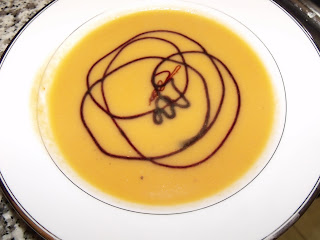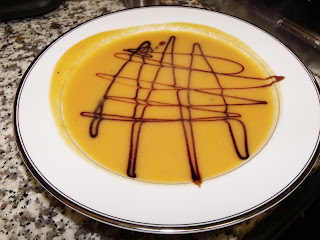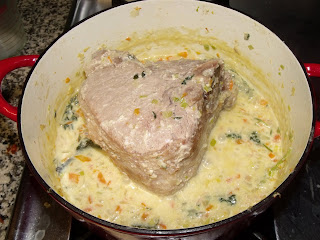Like I wrote in my Easter post, I just went through a pretty long stretch of not having time to cook much, or write, which meant a kind of involuntary hiatus from the
Les Halles Cookbook project. This is not too happy, as I have really enjoyed making these dishes, and I still have a ways to go, considering I'm not exactly holding myself to a rigorous schedule. So, last week I declared a hiatus to my hiatus, and pretty much spent the weekend cooking various things, including this steak au poivre.
After proposing a Les Halles dinner to Husband J, I asked him if there was anything he particularly wanted, and he requested steak. Since the red wine butter steak requires a grill or grill pan (though I may just make it on my cast iron skillet anyway so as not to purchase cluttery pans), I decided on steak au poivre, one of my favorite types of steak. This sounded like it needed a fresh spring salad, so I decided on the asparagus and haricots verts salad, since I figured it was high time to find those particular veggies fresh at the market. However, I must have been too late or too early, because there was not a haricot vert to be had, alas. I decided to make the salad anyway, with fresh spring greens instead of haricots verts.
With steak au poivre, the most important thing is, of course, cracked peppercorns. I measured out 2 ounces of peppercorns on my handy scale:

Now to crack them. Which was a problem, because suddenly I realized that outside of a grinder, I had no idea how to crack peppercorns. The magic that is google told me that one thing to do is put the peppercorns into a zip-loc and crack them with a rolling pin. Husband J offered me a hammer, which I snobbishly declined, wielding my rolling pin. But there was another problem, I didn't have a ziplock. I had the bright idea of wrapping the peppercorns in some saran-wrap. Once wrapped, I gave them a good whack with my rolling pin. And... the saran-wrap promptly split, spilling many of the corns onto my kitchen floor. Great. After sweeping the floor, I tried again with more loosely wrapped peppers. This did not lead to floor spillage, but didn't do much in the pepper cracking department. For a little while I found success cracking one peppercorn at a time, but as you can see above, that process would probably take me into the next decade. In the end, I swallowed my pride and took Husband J's hammer, which worked much better, particularly considering the peppercorns were denting the edge of the wooden rolling pin a little.
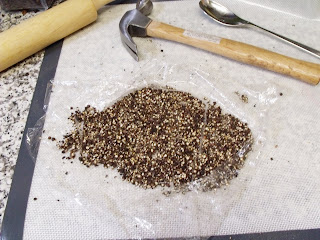 Cracked peppercorns and the implements of their destruction.
Cracked peppercorns and the implements of their destruction.With the peppercorns cracked, I started on the asparagus. The asparagus needs to get blanched for the salad, so I started up a big pot of salted water. Once the water boiled, the asparagus went in for about 5 minutes, and then into an ice bath to stop the cooking process. Easy!
 Asparagus in its ice water bath.
Asparagus in its ice water bath.By the way, notice how the asparagus in this photo is neatly wrapped and not all over the place like, say, all my bouquet garnis ever? Well after almost a year of searching, I have finally found kitchen twine. Hooray!
After measuring out the mise for the steak sauce, I took the steak out of the fridge and cut it into four portions.
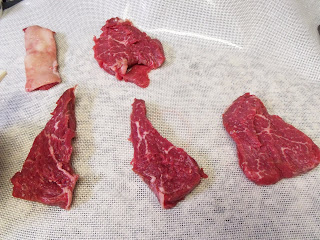
Next, I brushed the steaks with olive oil, and dredged them in the cracked peppercorns. They went into a pan of olive oil and butter to saute.
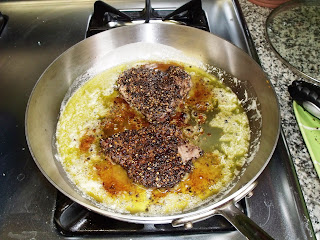
After getting browned on both sides, the steaks go into the oven for a few minutes, during which time I made the steak sauce. I stirred cognac into the oil/butter mix in the pan, and then reduced the liquid by half. Next I stirred some veal stock and demi-glace into the pan, and then reduced it some more. Finally, I whisked half a stick of butter into the pan to make a thick, creamy, cognac-y sauce laced with extra peppercorns.

To make the salad vinaigrette, I stirred some olive oil and lemon juice together, and then seasoned it with salt and white pepper--again, super easy. Finally, I tossed the asparagus, greens, and orange slices with the vinaigrette.
And the final product:

This was amazing. The steak was very delicious and tender, and the peppercorns added the perfect bite. The cognac sauce was absolutely brilliant and saturated fatty, and we ended up tearing bits of baguette, soaking them in the sauce, and eating them. The salad was also wonderful, and Husband J was boggled that it was only lemon juice and olive oil with a little seasoning. Of course, it helped that the veggies were perfectly fresh and in season, so thanks farmers at the market.
Husband J said that this dish was definitely one of the top ones that I've made, which made me very happy. It's nice to have something go perfectly, after the too-big-lamb debacle, and undercooked-pork horror.
Lessons Learned: Crack the peppercorns with a hammer--don't ruin your rolling pin. Fresh spring veggies taste amazing with just a little seasoning.
Next week: Thinking of something with veal...






